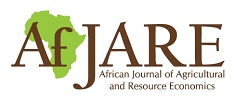African Journal of Agricultural and Resource Economics
(AfJARE)
Journal Africain d’Économie Agricole et des Ressources
(JAEAR)
Published by the African Association of Agricultural
Economists (AAAE)
ISSN 1993-3738
Volume 15, No. 2 (June 2020)
Empirical studies on the effects of governance structures on incentives have still received little attention in the wheat value chain research of developing countries. The purpose of this paper is to investigate the effects of governance structures on actors’ incentives in different functional nodes of the wheat value chain.
The study provides evidence for how risk preferences determine fishing location choices by artisanal fishers on the south-west coast of the island of Mauritius. Risk preference is modelled using a random linear utility framework defined over mean-standard deviation space.
The starting point for this article is the concept of a commodity exchange. A working definition is a physical or – more likely – electronic marketplace for buying, selling and trading commodities, whether ‘hard’ commodities, which typically are natural resources that must be mined or extracted (gold, rubber, oil, etc.), or ‘soft’ commodities, which are mainly agricultural products or livestock (coffee, corn, cotton, sugar, soybeans, etc.).
Dans le but d’appréhender l’influence des types de contrat de travail sur les performances des exploitations cacaoyères dans le Mbam et Kim au Cameroun, un échantillonnage raisonné a permis de sélectionner 114 exploitants cacaoyers. L’approche à deux étapes recourant aux modèles Data Enveloppent Analysis (DEA) et Tobit censuré a permis d’analyser l’efficacité des exploitations.
Unexpectedly lower yield outcomes (downside risks) challenge farmers’ use of external inputs that can enhance crop productivity. Using household-level panel data collected from Ethiopia, we estimated the effects of crop diversification through maize-legume intercropping/rotation on maize yield distribution and downside risk.
This paper conducts ex-ante impact assessments for policy interventions to promote amaranth value chains in Tanzania and Kenya. Amaranth is an underdeveloped, drought-resistant, and nutrition-rich crop used for human food, animal fodder, and ornamental purposes.
